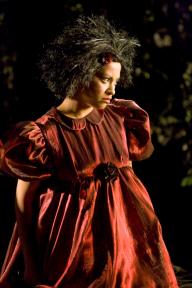Gormenghast: a trip to another reality

Withdrawn and ruinous it broods in umbra: the immemorial masonry: the towers, the tracks. Is all corroding? No."
Gormenghast. It is more than just a castle it is a whole world. And though our worlds have many things in common, we have no place like Gormenghast: it is a reality all its own. However, if one were to wonder what a wander down those passageways would feel like, then take a trip to the Freddy Wood at UBC. Director Stephen Malloy has assembled a stellar production team to give us everything we need to step over the threshold of our reality and into that of Mervyn Peake. His vivid imagination influenced by exposure to the aftermath of war and its atrocities, Peake wrote his sprawling epic over three books known as The Gormenghast Trilogy. The play adaptation by John Constable takes its story from the first two volumes.
Titus Groan is born, grows to adolescence, and perhaps manhood. But to say the story is that simple would be an insult to Peake as well as Crow (Constable’s shamanic name). In following the 77th Earl of Gormenghast, Crow introduces us to the assortment of characters that inhabit this world and takes us on an adventure that spans more than 15 years. Central to this tale is the structure of Gormenghast castle itself. A castle without compare, as Peake describes it and the surrounding dependants:
"These dwellings, by ancient law, were granted this chill intimacy with the stronghold that loomed above them. Over their irregular roofs would fall throughout the seasons, the shadows of time-eaten buttresses, of broken and lofty turrets, and, most enormous of all, the shadow of the Tower of Flints. This tower, patched unevenly with black ivy, arose like a mutilated finger from among the fists of knuckled masonry and pointed blasphemously at heaven. At night the owls made of it an echoing throat; by day it stood voiceless and cast its long shadow."
One has but to read this small passage to know that Ronald Fedoruk has intimate knowledge of the legendary abode. His scenography transports the viewer to the imaginary castle in the opening moments and keeps us firmly ensconced in this alternate reality through dungeons, turrets, fire, flood, forest and the ominous "Field of Stones". He and Malloy capture the loneliness, desolation and the vastness associated with the castle. The physical movement the actors use to transport themselves through the halls and passageways allow us to travel along with them. Couple this with stunning costumes by Carmen Alatorre and you have a visual treat that would move stone, and it quite literally does. A subtle soundscape adds just enough otherworldly ambiance that you'll believe yourself present in the tale, not watching so much as sharing in the experience.
Where this 'shared experience' breaks down somewhat is in the translation of the 'spoken' word. Crow creates his characters accurately from the story but he does so in a way that paints them as much larger than life. This is not to say they are simply caricatures but they are definitely not people you’d encounter everyday. To do honour to those inhabiting this world, I would suggest the actor must have read the books start to finish at least once. There are so many details and clues peppered through out Peake’s writing that one could have a complete vision of a person yet be continually surprised by them. And while Crow may give each character an introduction at young Titus' christening at the top of the show, these are almost identical to the character descriptions I read in the program (kind of spoiled a few laughs I felt). It takes a very skilled actor to pull off such a large character without being over the top or, conversely, not being big enough. For the most part, these students are still learning. Several of the cast were closer to hitting the mark, notably Krissy Jesudason (Fuschia), Tianna Nori (Dr Prunesquallor), Colin Ormiston (Barquentine) and also Jeanna Haddow who as a the puppeteer plays the castle cats (and also a monkey, a sad monkey). That is not to say the rest did not perform well but it was noticeable that with songs by Patrick Pennefather punctuating the script, some of the actors were more at home singing their roles than talking them.
In the end, this is a student/ teacher production, and as such it will have both strengths and weaknesses. For the first show of this year it bodes well for those to come, if you can make this epic appealing to the public, beyond the story itself, you'll keep us coming back for more. The professors have set a standard that some of the students have risen to, and the rest I'm sure, have learned from. No matter how big you get, your subtleties are the details of character.
"Through an avenue off spires a zephyr floats; a bird whistles; a freshet bears away from a choked river. Deep in a fist of stone a doll's hand wriggles, warm rebellious on the frozen palm. A shadow shifts its length. A spider stirs...
And darkness winds between the characters."



